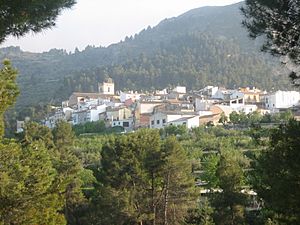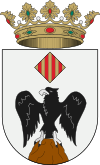Penàguila facts for kids
Quick facts for kids
Penàguila
|
||
|---|---|---|
|
Town
|
||

General view of Penàguila
|
||
|
||
| Country | ||
| Autonomous Community | ||
| Province | Alicante | |
| Comarca | Alcoiá | |
| Founded | 324 BC | |
| Population
(2018)
|
||
| • Total | 301 | |
| Demonym(s) | penaguilenc, -a (va) | |
| Time zone | UTC+1 (CET) | |
| • Summer (DST) | UTC+2 (CEST) | |
| Postal code |
03815
|
|
| Area code(s) | +34 (ES) + 96 (A) | |
Penàguila is a small town in Spain. It is located in the Valencian Community, within the Province of Alicante. The town is part of a region called Alcoià.
Contents
Exploring Penàguila's Location
Penàguila is found at the base of the Sierra de Penàguila mountains. This area is part of the northern slopes of the Sierra de Aitana. The town is open towards the valley of Alcoy.
Rivers and Waterways
A river called Frainós, also known as Penàguila, flows through the eastern part of the town. This river eventually joins the Alcoy or Serpis river near Cocentaina.
A Look at Penàguila's History
Penàguila has a long history, dating back to Muslim times. The town was once surrounded by strong walls. Today, you can still see some parts of these old walls and towers.
Early Rulers and Charters
In 1276, King James I of Aragon promised the Penàguila Castle to a person named Berenguer Mayor. He also planned to divide the land among the people who guarded the castle. Two years later, in 1278, King Peter III gave Penàguila a special document called a town charter. This charter gave the town certain rights and freedoms.
In 1338, another ruler, Pedro of Aragon, ordered that the castle be made even stronger. For a long time, in the 1400s and 1500s, a family called Fenollar owned the manor. Later, it became part of the royal lands. Penàguila was a royal town, meaning it had a say in the regional government meetings called the Corts Valencianes.
Population Changes
Unlike some other places nearby, Penàguila had mostly a Christian population. This meant that when the Moors were expelled from Spain in 1609, Penàguila did not lose many people. Before the expulsion, there were about 200 homes. Afterward, there were still 145. This shows that the town's population did not decrease much.
Administrative Changes Over Time
Penàguila was part of the Xàtiva region until 1707. Then, it belonged to the township of Alcoy until 1833. In 1833, Spain was divided into provinces. Penàguila then became part of the Province of Alicante.
Penàguila's Economy
Most of Penàguila's land is used for farming. About 54% of the area is farmland, while 46% is forest.
Farming and Crops
Most of the farming in Penàguila relies on rainfall, not irrigation. This is called dry farming. The main crop grown here is olives, covering over 1,400 hectares. Almonds are also important, grown on about 365 hectares. There are also smaller areas with fruit trees like peaches, plums, and apples.
Only a small part of the land (41 hectares) is irrigated. This land is used to grow vegetables and different kinds of fruit. Farmers in Penàguila work together in a group called the Virgen del Patrocinio cooperative.
See also
 In Spanish: Penáguila para niños
In Spanish: Penáguila para niños



